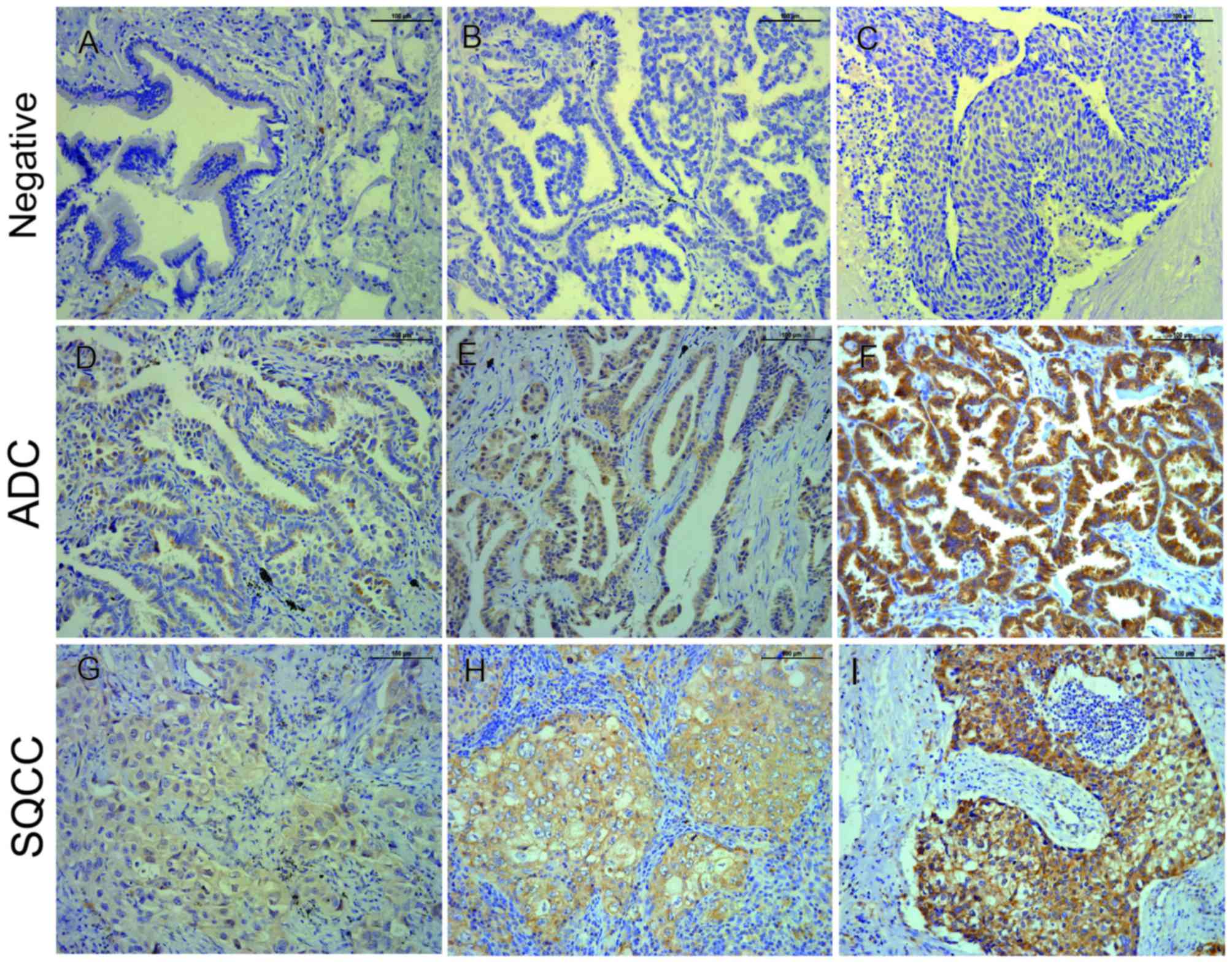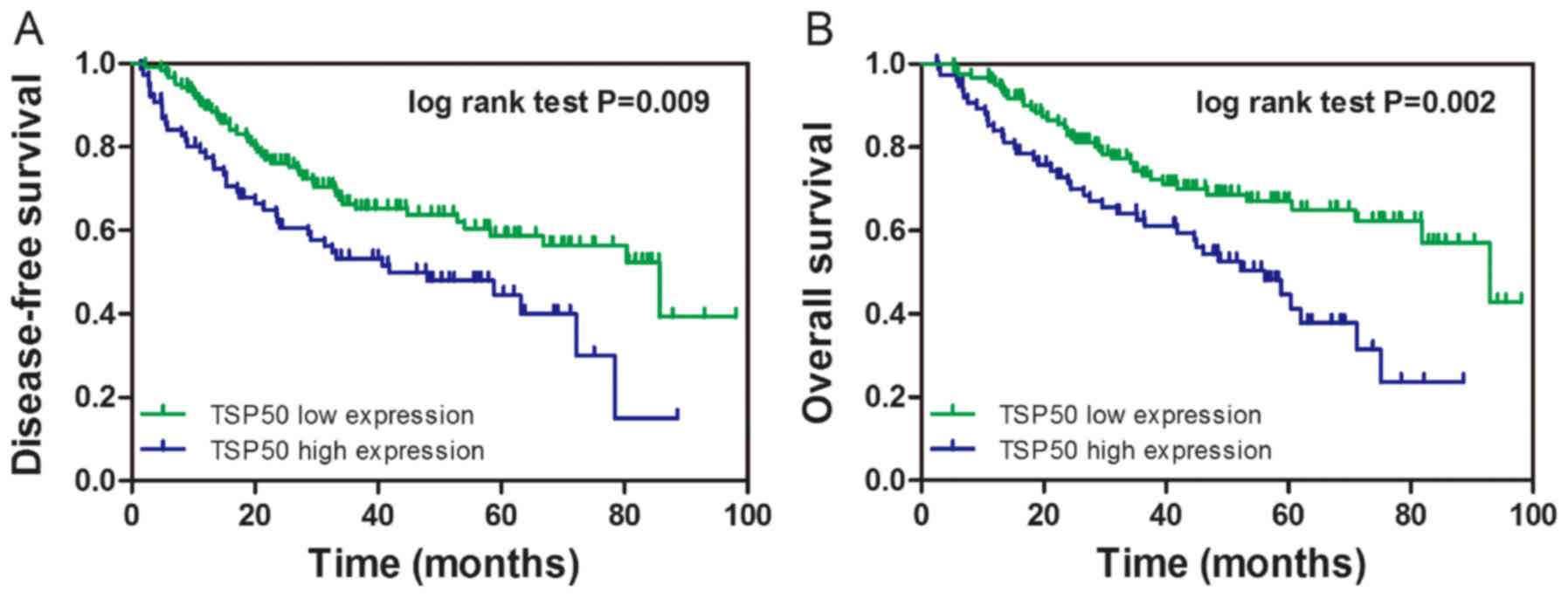|
1
|
Herbst RS, Heymach JV and Lippman SM: Lung
Cancer. N Engl J Med. 359:1367–1380. 2008. View Article : Google Scholar : PubMed/NCBI
|
|
2
|
Torre LA, Bray F, Siegel RL, Ferlay J,
Lortet-Tieulent J and Jemal A: Global cancer statistics, 2012. CA
Cancer J Clin. 65:87–108. 2015. View Article : Google Scholar : PubMed/NCBI
|
|
3
|
Spira A and Ettinger DS: Multidisciplinary
management of lung cancer. N Engl J Med. 350:379–392. 2004.
View Article : Google Scholar : PubMed/NCBI
|
|
4
|
Goldstraw P: The 7th edition of TNM in
lung cancer: What now? J Thorac Oncol. 4:671–673. 2009. View Article : Google Scholar : PubMed/NCBI
|
|
5
|
Yuan LM, Shan JD, De Risi D, Broome J,
Lovecchio J, Gal D, Vinciguerra V and Xu HP: Isolation of a novel
gene, TSP50, by a hypomethylated DNA fragment in human breast
cancer. Cancer Res. 59:3215–3221. 1999.PubMed/NCBI
|
|
6
|
Shan J, Yuan L, Xiao Q, Chiorazzi N,
Budman D, Teichberg S and Xu HP: A possible protease in human
testes, is activated in breast cancer epithelial cells1. Cancer
Res. 62:290–294. 2002.PubMed/NCBI
|
|
7
|
Xu H, Shan J, Jurukovski V, Yuan L, Li J
and Tian K: TSP50 encodes a testis-specific protease and is
negatively regulated by p53. Cancer Res. 67:1239–1245. 2007.
View Article : Google Scholar : PubMed/NCBI
|
|
8
|
Song ZB, Bao YL, Zhang Y, Mi XG, Wu P, Wu
Y, Yu CL, Sun Y, Zheng LH and Huang YX: Testes-specific protease 50
(TSP50) promotes cell proliferation through the activation of the
nuclear factor κB (NF-κB) signalling pathway. Biochem J.
436:457–467. 2011. View Article : Google Scholar : PubMed/NCBI
|
|
9
|
Song ZB, Ni JS, Wu P, Bao YL, Liu T, Li M,
Fan C, Zhang WJ, Sun LG, Huang YX and Li YX: Testes-specific
protease 50 promotes cell invasion and metastasis by increasing
NF-kappaB-dependent matrix metalloproteinase-9 expression. Cell
Death Dis. 6:e17032015. View Article : Google Scholar : PubMed/NCBI
|
|
10
|
Zheng L, Xie G, Duan G, Yan X and Li Q:
High Expression of Testes-specific protease 50 is associated with
poor prognosis in colorectal carcinoma. PLoS One. 6:e222032011.
View Article : Google Scholar : PubMed/NCBI
|
|
11
|
Liu F, Cao Q, Liu N, Li C, You C, Liu C,
Xue L and Luo R: Overexpression of testes-specific protease 50
(TSP50) predicts poor prognosis in patients with gastric cancer.
Gastroenterol Res Pract. 2014:4982462014. View Article : Google Scholar : PubMed/NCBI
|
|
12
|
Yuan J, Wu C, Huang M, Zhou J, Ben W and
Zhang G: TSP50 depends on its threonine protease activity and its
interactions with TNF-α-induced NF-κB for its role in human
cervical tumorigenesis. Cell Biochem Biophys. 71:891–896. 2015.
View Article : Google Scholar : PubMed/NCBI
|
|
13
|
Maggiore C, Mulè A, Fadda G, Rossi ED,
Lauriola L, Vecchio FM and Capelli A: Histological classification
of lung cancer. Rays. 29:353–355. 2004.PubMed/NCBI
|
|
14
|
Wang M, Bao YL, Wu Y, Yu CL, Meng XY,
Huang YX, Sun Y, Zheng LH and Li YX: Basic FGF Downregulates TSP50
expression via the ERK/Sp1 Pathway. J Cell Biochem. 111:75–81.
2010. View Article : Google Scholar : PubMed/NCBI
|
|
15
|
Song ZB, Liu B, Li YY, Wu P, Bao YL, Huang
YX, Wu Y, Sun LG, Yu CL, Sun Y, et al: The catalytic triad of
testes-specific protease 50 (TSP50) is essential for its function
in cell proliferation. Cell Signal. 26:2266–2275. 2014. View Article : Google Scholar : PubMed/NCBI
|
|
16
|
Wei J, Liu Y, Yang S, Xu J, Kong H, Han B,
Bao Y, Wu Y, Yin W, Li W, et al: Screening of single-chain variable
fragments against TSP50 from a phage display antibody library and
their expression as soluble proteins. J Biomol Screen. 11:546–552.
2006. View Article : Google Scholar : PubMed/NCBI
|
|
17
|
Liu YL and Sun YN: Down-regulation of
testes-specific protease 50 induces apoptosis in human
laryngocarcinoma HEp2 cells in a NF-κB-mediated pathway. Mol Biol.
41:7743–7747. 2014.
|
|
18
|
Kosaka-Suzuki N, Suzuki T, Pugacheva EM,
Vostrov AA, Morse HC III, Loukinov D and Lobanenkov V:
Transcription factor BORIS (Brother of the Regulator of Imprinted
Sites) directly induces expression of a cancer-testis antigen,
TSP50, through regulated binding of BORIS to the Promoter. J Biol
Chem. 286:27378–27388. 2011. View Article : Google Scholar : PubMed/NCBI
|
|
19
|
Cheng YH, Wong EW and Cheng CY:
Cancer/testis, (CT) antigens, carcinogenesis and spermatogenesis.
Spermatogenesis. 1:209–220. 2011. View Article : Google Scholar : PubMed/NCBI
|
|
20
|
Kim YD, Park HR, Song MH, Shin DH, Lee CH,
Lee MK and Lee SY: Pattern of cancer/testis antigen expression in
lung cancer patients. Int J Mol Med. 29:656–662. 2012. View Article : Google Scholar : PubMed/NCBI
|
|
21
|
Grah JJ, Katalinic D, Juretic A, Santek F
and Samarzija M: Clinical significance of immunohistochemical
expression of cancer/testis tumor-associated antigens (MAGE-A1,
MAGE-A3/4, NY-ESO-1) in patients with non-small cell lung cancer.
Tumori. 100:60–68. 2014. View Article : Google Scholar : PubMed/NCBI
|
|
22
|
Zhang XP: Depression of testes-specific
protease 50 (TSP50) inhibits cell proliferation and induces
apoptosis in laryngocarcinoma. Tumour Biol. 35:10781–10788. 2014.
View Article : Google Scholar : PubMed/NCBI
|
|
23
|
Li YY, Bao YL, Song ZB, Sun LG, Wu P,
Zhang Y, Fan C, Huang YX, Wu Y, Yu CL, et al: The threonine
protease activity of testes-specific protease 50 (TSP50) is
essential for its function in cell proliferation. PLoS One.
7:e350302012. View Article : Google Scholar : PubMed/NCBI
|
|
24
|
Gjerstorff MF, Andersen MH and Ditzel HJ:
Oncogenic cancer/testis antigens: Prime candidates for
immunotherapy. Oncotarget. 6:15772–15787. 2015. View Article : Google Scholar : PubMed/NCBI
|
|
25
|
Zhou L, Bao YL, Zhang Y, Wu Y, Yu CL,
Huang YX, Sun Y, Zheng LH and Li YX: Knockdown of TSP50 inhibits
cell proliferation and induces apoptosis in P19 cells. IUBMB Life.
62:825–832. 2010. View
Article : Google Scholar : PubMed/NCBI
|
|
26
|
Molina JR, Yang P, Cassivi SD, Schild SE
and Adjei AA: Non-small cell lung cancer: Epidemiology, risk
factors, treatment, and survivorship. Mayo Clin Proc. 83:584–94.
2008. View Article : Google Scholar : PubMed/NCBI
|
|
27
|
Mostafa AA and Morris DG: Immunotherapy
for lung cancer: Has it finally arrived? Front Oncol. 4:2882014.
View Article : Google Scholar : PubMed/NCBI
|
















